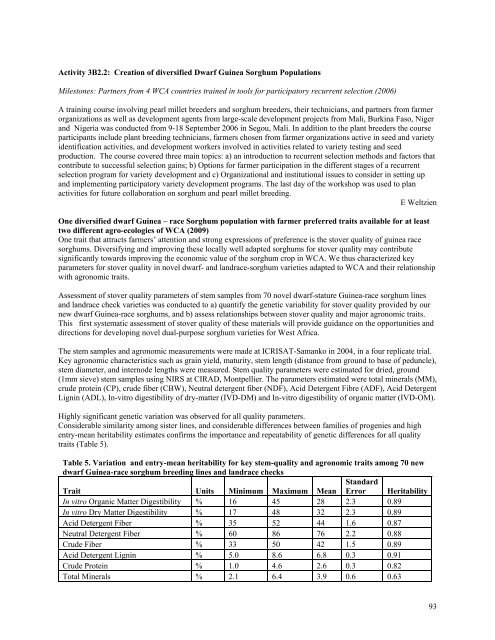ICRISAT Archival Report 2006 - The seedlings of success in the ...
ICRISAT Archival Report 2006 - The seedlings of success in the ...
ICRISAT Archival Report 2006 - The seedlings of success in the ...
Create successful ePaper yourself
Turn your PDF publications into a flip-book with our unique Google optimized e-Paper software.
Activity 3B2.2: Creation <strong>of</strong> diversified Dwarf Gu<strong>in</strong>ea Sorghum Populations<br />
Milestones: Partners from 4 WCA countries tra<strong>in</strong>ed <strong>in</strong> tools for participatory recurrent selection (<strong>2006</strong>)<br />
A tra<strong>in</strong><strong>in</strong>g course <strong>in</strong>volv<strong>in</strong>g pearl millet breeders and sorghum breeders, <strong>the</strong>ir technicians, and partners from farmer<br />
organizations as well as development agents from large-scale development projects from Mali, Burk<strong>in</strong>a Faso, Niger<br />
and Nigeria was conducted from 9-18 September <strong>2006</strong> <strong>in</strong> Segou, Mali. In addition to <strong>the</strong> plant breeders <strong>the</strong> course<br />
participants <strong>in</strong>clude plant breed<strong>in</strong>g technicians, farmers chosen from farmer organizations active <strong>in</strong> seed and variety<br />
identification activities, and development workers <strong>in</strong>volved <strong>in</strong> activities related to variety test<strong>in</strong>g and seed<br />
production. <strong>The</strong> course covered three ma<strong>in</strong> topics: a) an <strong>in</strong>troduction to recurrent selection methods and factors that<br />
contribute to <strong>success</strong>ful selection ga<strong>in</strong>s; b) Options for farmer participation <strong>in</strong> <strong>the</strong> different stages <strong>of</strong> a recurrent<br />
selection program for variety development and c) Organizational and <strong>in</strong>stitutional issues to consider <strong>in</strong> sett<strong>in</strong>g up<br />
and implement<strong>in</strong>g participatory variety development programs. <strong>The</strong> last day <strong>of</strong> <strong>the</strong> workshop was used to plan<br />
activities for future collaboration on sorghum and pearl millet breed<strong>in</strong>g.<br />
E Weltzien<br />
One diversified dwarf Gu<strong>in</strong>ea – race Sorghum population with farmer preferred traits available for at least<br />
two different agro-ecologies <strong>of</strong> WCA (2009)<br />
One trait that attracts farmers’ attention and strong expressions <strong>of</strong> preference is <strong>the</strong> stover quality <strong>of</strong> gu<strong>in</strong>ea race<br />
sorghums. Diversify<strong>in</strong>g and improv<strong>in</strong>g <strong>the</strong>se locally well adapted sorghums for stover quality may contribute<br />
significantly towards improv<strong>in</strong>g <strong>the</strong> economic value <strong>of</strong> <strong>the</strong> sorghum crop <strong>in</strong> WCA. We thus characterized key<br />
parameters for stover quality <strong>in</strong> novel dwarf- and landrace-sorghum varieties adapted to WCA and <strong>the</strong>ir relationship<br />
with agronomic traits.<br />
Assessment <strong>of</strong> stover quality parameters <strong>of</strong> stem samples from 70 novel dwarf-stature Gu<strong>in</strong>ea-race sorghum l<strong>in</strong>es<br />
and landrace check varieties was conducted to a) quantify <strong>the</strong> genetic variability for stover quality provided by our<br />
new dwarf Gu<strong>in</strong>ea-race sorghums, and b) assess relationships between stover quality and major agronomic traits.<br />
This first systematic assessment <strong>of</strong> stover quality <strong>of</strong> <strong>the</strong>se materials will provide guidance on <strong>the</strong> opportunities and<br />
directions for develop<strong>in</strong>g novel dual-purpose sorghum varieties for West Africa.<br />
<strong>The</strong> stem samples and agronomic measurements were made at <strong>ICRISAT</strong>-Samanko <strong>in</strong> 2004, <strong>in</strong> a four replicate trial.<br />
Key agronomic characteristics such as gra<strong>in</strong> yield, maturity, stem length (distance from ground to base <strong>of</strong> peduncle),<br />
stem diameter, and <strong>in</strong>ternode lengths were measured. Stem quality parameters were estimated for dried, ground<br />
(1mm sieve) stem samples us<strong>in</strong>g NIRS at CIRAD, Montpellier. <strong>The</strong> parameters estimated were total m<strong>in</strong>erals (MM),<br />
crude prote<strong>in</strong> (CP), crude fiber (CBW), Neutral detergent fiber (NDF), Acid Detergent Fibre (ADF), Acid Detergent<br />
Lign<strong>in</strong> (ADL), In-vitro digestibility <strong>of</strong> dry-matter (IVD-DM) and In-vitro digestibility <strong>of</strong> organic matter (IVD-OM).<br />
Highly significant genetic variation was observed for all quality parameters.<br />
Considerable similarity among sister l<strong>in</strong>es, and considerable differences between families <strong>of</strong> progenies and high<br />
entry-mean heritability estimates confirms <strong>the</strong> importance and repeatability <strong>of</strong> genetic differences for all quality<br />
traits (Table 5).<br />
Table 5. Variation and entry-mean heritability for key stem-quality and agronomic traits among 70 new<br />
dwarf Gu<strong>in</strong>ea-race sorghum breed<strong>in</strong>g l<strong>in</strong>es and landrace checks<br />
Standard<br />
Trait Units M<strong>in</strong>imum Maximum Mean Error Heritability<br />
In vitro Organic Matter Digestibility % 16 45 28 2.3 0.89<br />
In vitro Dry Matter Digestibility % 17 48 32 2.3 0.89<br />
Acid Detergent Fiber % 35 52 44 1.6 0.87<br />
Neutral Detergent Fiber % 60 86 76 2.2 0.88<br />
Crude Fiber % 33 50 42 1.5 0.89<br />
Acid Detergent Lign<strong>in</strong> % 5.0 8.6 6.8 0.3 0.91<br />
Crude Prote<strong>in</strong> % 1.0 4.6 2.6 0.3 0.82<br />
Total M<strong>in</strong>erals % 2.1 6.4 3.9 0.6 0.63<br />
93

















